
by
Dr. Richard E. Hayes
President, Evidence Based Research, Inc.
Dr. David S. Alberts
Director, Directorate of Advanced Concepts, Technologies, and Information Strategies
October 1995
"Information warfare" has become the buzzword for those looking to the future of U.S. national security as we approach the 21st century. Consensus has emerged that those capable of acquiring, leveraging, and protecting information and information processing systems will dominate the first decades of that era. However, little systematic thought has been given to the overall size and shape of the realm within which these contests will occur, the range of actors who will play significant roles, the instruments that will be brought to bear, or the opportunities and vulnerabilities inherent in the process.
This paper provides an initial exploration of the arena and attempts to (a) identify the key dimensions of the problem, (b) locate the most important areas of the global information systems, and (c) generate insights about the processes of important information interactions.
The simple, but crucial, step of defining what is encompassed by the term "information" is all too often ignored by those who write about its importance and its future. Most typically in the fields of communication and computer systems "information" derives its technical meaning only when it is contrasted with the lesser category of "data." In this formulation, unsorted, inchoate data and reports (for example, raw sensor information or a set of unanalyzed news reports) are seen as data. Once sorted, classified, or interpreted into useful form (air tracks, an assessment of enemy military readiness, etc.) this same material becomes information. Thus, the key distinction is between data as raw material, and information as a product with added value for its users because of the processes by which it has been selected, organized, and presented.
In fact, however, information dominance and information warfare include much more than simple data and its value-added transformation into information useful for decision making. As Figure 1 indicates, the hierarchy of "information" can be related to the scientific process of exploring a new field, developing theories about a knowledge domain, and applying it to achieve specific purposes. In this paper "information" has been italicized when it refers to the full range of meanings -- from data through wisdom.

At the lowest level, scientists approach a new field by observation, which involves the assembly of large amounts of raw data. New tools emerge for better observation and large enough sets exist to allow comparison. Types of objects may then be identified that can be reliably classified by characteristics that have validity (are substantive meaningful differences). With these classifications, scientists can begin to exchange information and identify patterns - learning what is associated with what, what is common or rare, and so forth.
Understanding about a set of objects emerges when explanations can be offered that link the classifications together by means of causal statements. Simple correlations do not provide causal information since they can result from unseen factors or random chance. However, once the causal mechanisms for differences and changes over time have been found, the field approaches a new level of maturity, with the corresponding transformation from having information to developing knowledge.
Prediction requires more than simple understanding. It implies that the cause and effect relationships are so well known that the implications of changes in the environment on the causal processes can be established before the fact. For example, knowing that supply and demand interact to produce price in an efficient market is insufficient to predict the impact of a change in supply unless the nature of the market (monopoly, oligopoly, competitive, etc.) and the elasticity of demand for the goods in question are also known. Hence, "knowledge" requires both an understanding of the causal relationships at work and the boundaries or limiting conditions where and at which those causal relationships are transformed.
Finally, "prescription" deals with the wise use of knowledge. The human condition and modern society are so complex that unintended consequences abound. Hence, the moral science of prescription -- deciding what to control and what degree of control to exercise -- requires not only knowledge, but also informed judgment.
Understanding that the term "information" is used to encompass all these forms provides a crucial insight into the breadth of "information dominance." First, one immediately grasps that attacks on an adversary may be directed at all these different levels of information. Defenses of information must, therefore, be built to protect all these levels as well. By the same token, successfully leveraging information requires coherence and validity at all five levels -- proper measurement and classification in order to support analysis of the correct relationships to reach conclusions that are valid over time and can be acted upon effectively. Hence, those who concern themselves only with the narrow concepts of protecting or attacking at the levels of data or information content will both miss major opportunities and fail to recognize those types of information with greatest leverage.
The realm where information dominance is sought can only be fully described by specifying three key aspects of these contests:
Each of these three aspects of the information dominance realm is large and complex, but none of them are genuinely independent. That is, the type of actor, type of interaction, and arena of interaction must all be known to reach an intelligent understanding of what has occurred, is occurring, or may occur. In reality, there are multiple "contests" occurring simultaneously.
Because the ideas of information war and dominance are usually portrayed in a negative environment, they are often imperfectly perceived. In fact, as Figure 2 illustrates, the quality of significant information interactions depends upon the goal compatibility of the entities involved in the interaction. These range from pure positive or cooperative models to purely negative (or combative) ones.
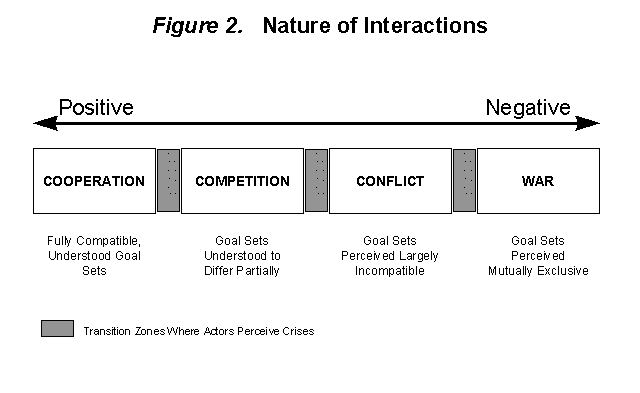
The information warfare literature begins with the assumption that two entities (e.g., nation states or groups of countries) have decided that their goals in important arenas are mutually exclusive, which requires one actor to seek to impose its will on another through force of arms. The traditional view has been that the imposition of will is accomplished largely through means of kinetic weapons or weapons of mass destruction. The information warfare prophets of the "Revolution in Military Affairs" (RMA) foresee employing information based systems and weapons through "soft kills" and sowing confusion on the other side, to either defeat military forces (for example, by persuading the general population or political elite to abandon a struggle) or have a decisive impact by creating dominant battlefield awareness for one side. This includes a variety of subsets of information warfare that have been commonly identified, including command and control warfare (C2W), electronic warfare (EW), and information based warfare (IBW).
The narrow nature of this interpretation becomes apparent when coalition warfare (expected to be a common mode of operation in the 21st century) is considered. Effective information dominance in this context involves both a set of conflictual interactions (the information warfare with an adversary) and a set of cooperative interactions (coalition planning and appropriate sharing of information), potentially involving competition based on complementary, but not fully compatible, goals such as conducting effective warfare without compromising intelligence sources and methods. Thus, the concept of information dominance goes far beyond what is typically considered the information warfare of the 21st century.
Another weakness of considering information dominance only in the context of information warfare emerges in debates about the proper boundaries between war, conflict by other means (economic, ideological, etc.), and "legitimate" international competition. Economic competition in the global marketplace is seen as "good" by economists, who see intervention by governments to gain advantage in that competition (import substitution policies, tariffs and other barriers to protect domestic industries, etc.) as "bad." However, governments routinely gather information about the strengths, weaknesses, strategies, and vulnerabilities of foreign companies and seek to provide support (political, informational, economic, etc.) of their own corporations in order to generate employment and collect more in taxes. Recent trends appear to reinforce the nation state in acting to support the domestic economic system.
Indeed, there are a number of areas where cooperative economic and other interactions among international actors are highly beneficial or absolutely essential. OPEC represents an economic effort at cooperation by some governments. Free trade zones and trading blocks are strategies employed by countries perceiving compatible goal sets. Global environment issues are increasingly arenas where cooperative information exchanges are perceived as essential.
Continuing to think about information warfare rather than information dominance will lead to myopic views regarding the possibilities for harnessing and protecting information to achieve national ends. This is not a question of offensive or defensive uses of information, nor the use of information to make the instruments of power more effective. Rather, this is the use of overall information dominance in arenas other than direct warfare or conflict to advance national ends. Failure to understand that information dominance can only be obtained through the correct mix of positive and negative interactions could make the task of crafting an effective strategy for information dominance all but impossible. The full range of positive through negative interactions, often some of these with mixed strategy across arenas and actors, will be essential to success. Some types of cooperation will be essential to effective competition. Cooperation in some arenas will prove essential to managing conflicts and conducting successful warfare in others.
The broad areas where societies interact have been organized in Figure 3 from the most concrete to the most abstract, using traditional mid-20th century concepts. The military arena here represents concrete forces -- kinetic weapons and weapons of mass destruction, military formations organized and equipped to fight in areas as sophisticated as tank battles and as primitive and guerrilla fighting in the jungle. The quality of information about the battlefield (completeness, accuracy, currency, precision, and consistency across the military force) has long been accepted as an important determinant of fighting capability and military mission success.
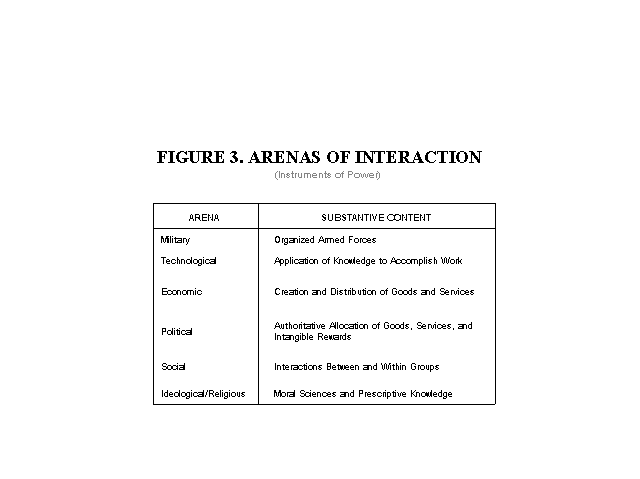
Only slightly less concrete is the technological area in which knowledge is applied to accomplish work (physical or mental). Military systems typically represent some of the most advanced and most reliable forms of technical application, both in engines of destruction and in supporting activities such as transportation or information technology. Societies compete fiercely in some technology areas and cooperate in others (for example, safety equipment and anti-pollution devices), though mixed motives are quite common. Protecting technologies, gathering information about the technologies of potential rivals, and leveraging technology are major arenas for interaction.
The economic system, which creates and distributes goods and services, is one of the key dimensions of interaction. Efforts to collect, protect or leverage data, information, models or explanations, predictions and prescriptions (including plans) in the economic arena are a classic application of information systems.
Political systems by which power is brokered and goods, services and other rewards are allocated authoritatively are less concrete than economic systems, but very important nonetheless. Social structures, which organize the interactions between and within groups, also contain and depend heavily upon information. Understanding the cleavages and bonds that undergird a society or define the relationships between two actors can be very important.
Finally, and in many ways quite important, interactions take place in an ideological or religious dimension that represents the moral science or prescriptive knowledge of a society. Without insight into this type of interaction, prediction is all but impossible because the goal structure of potential allies, neutrals or adversaries is almost impossible to understand. With such knowledge, however, highly leveraged courses of action are possible.
Two other points need to be made with respect to the arenas of interaction. The first is that depicting these dimensions as a continuum is an artificial way to decompose reality for purposes of analysis -- significant interactions and activities often cut across these boundaries, though they typically have a dominant arena. For example, warfare clearly has military, technological, economic, political, social, and moral components. The more connected a process or entity across these levels, the more important the interactions in which it participates. Those that are richly connected across arenas usually offer greater opportunities for mixing positive and negative interactions, thereby avoiding overt conflict. At the same time, however, those that are richly connected also offer multiple avenues of approach to any adversary seeking to operate conflictually. Thus, the existence of rich connectivity creates vulnerabilities and "encourages" the spread of conflict or war into traditionally non-military realms.
The other key point is that these arenas are both the context of interaction and the classes of instruments of power that can be applied. Attacks that cross arenas can be particularly effective. The classic idea of winning political victories that force a military adversary to retire from a conflict is one of the more obvious forms of asymmetric battles. Economic sanctions, use of computer disruption of financial systems in foreign countries, attacks exploiting social differences in a society, and the use of military forces to gain access to raw materials or valuable land represent other asymmetries that exploit the holistic nature of the conflict arena.
At the current point in history, the potential for asymmetric information exploitation (including patterns of cooperation that gain technological or other advantages as well as negative interactions) is extremely significant for information dominance and makes focus on information warfare particularly dangerous. Focusing attention and defensive measures only on a single level of society, but particularly concentration on the military sector, will leave major vulnerabilities and will lead to important missed opportunities. The military sector in most societies is subject to political, social, economic, technological, and moral attack. Understanding that true national security involves effective control of all these arenas is essential for successful creation of information dominance.
An enormous variety of actors is relevant to the actors information dominance. Figure 4 shows one way to think about this variety -- organizing them by levels of analysis. As it shows, thinking through global information interactions requires more than dealing with the sovereign states that compose the international system. A wide variety of other entities must be considered.
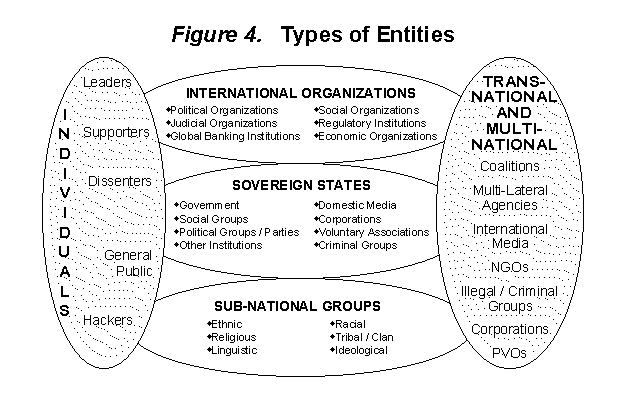
On one level, the legal status of groups can be used as an organizing principle. Sovereign states have created a variety of international organizations to perform global functions. These include a range of functional entities that most sovereign states find useful. These seek to provide both forums for working out successful patterns of international interaction (political and judicial organizations), or ways of implementing significant programs (banking, social, regulatory and economic organizations). At the same time, there are subnational groups, formed around a wide range of issues, that may cut across or fall within sovereign states, but lack the attributes of sovereignty (territory, legitimacy or recognition, and monopoly of coercive force). Increasingly, however, there is a third type of actor that tends to exist outside of or cut across state boundaries -- transnational and multinational groups and organizations. These vary widely in legitimacy, purpose, and visibility, sharing only the unique capability to defy sovereign governments by moving their activities across national borders.
Finally, but very important, information interactions also involve specific individuals. These include leaders of governments, groups, institutions, and other entities as well as their supporters and dissenters. The "general public" also plays a major role in many interactions (notably the social, economic, and political) and, therefore, makes a significant potential target. Even isolated individuals, such as computer hackers, must be considered when the arena is defined because they have the potential for highly disruptive or dangerous actions.
This mass of actors and potential actors greatly complicates the problems of information dominance. On one level, it makes the target environment immensely rich. On another level, the threat matrix is also huge. Deciding how to deal with the vast array of potential information arena entities remains a central challenge.
The three most important dimensions of the information dominance realm are brought together in Figure 5. For simplicity, the levels of interaction dimension has been integrated into a continuum ranging from the individual level through interactions between discrete organizations (tactical operations for the military) to the national (operational) level and the international (strategic) to the global (public) level. Other distinctions between actors, such as their legal status, were judged less important than the level of complexity and range of issues they address.
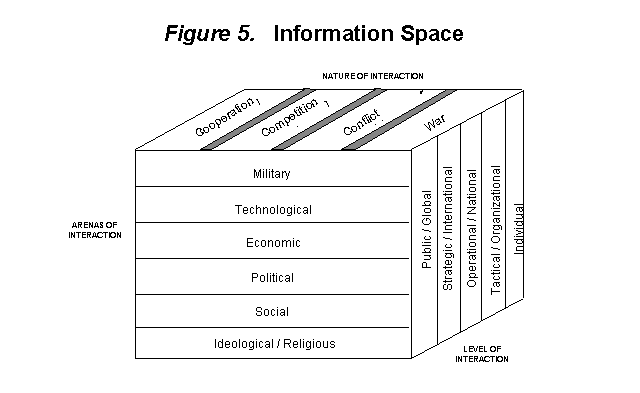
The key insight that emerges when these three dimensions are brought together is the very large overall space within which information dominance must be sought. On the one hand, specific arenas, such as counter-command and control warfare (C2W) or the broader information warfare concept actually occupy only a small portion of the relevant space. While they may be very important, these are but part of the overall problem.
Perhaps more important is the fact that narrowly defined information warfare ideas are doomed to failure. On one hand, they are doomed because they can be readily flanked. Massive military capability can be rendered impotent by sophisticated media attacks. Economic power can be attacked based on concepts of social differences and "fair" competition, resulting in boycotts, legal barriers, or other asymmetric strategies. Building powerful information infrastructures that depend on the global information industry for maintenance may well build in vulnerabilities or even systematic structures that permit electronic espionage.
Asymmetries of different types may also create vulnerabilities. Groups or organizations with different agendas undertake attacks in forms that cannot be predicted from threat analyses that focus on national targets. Individual hackers have shown remarkable flexibility and resilience when attacking large systems. Differing perceptions of goals compatibility can also lead to inappropriate cooperation, virtually giving away key information. Indeed, "false flag" operations will undoubtedly be an important tool for gathering information where social cleavages or other differences can be exploited.
Finally, the integration of systems across arenas and the access implied for a wide range of actors and the mix of motives they will have combine to ensure massive vulnerabilities. As information sciences tie the world together more closely, three types of key vulnerabilities are magnified. First, the ability of any given actor to acquire information (legally or illegally, openly or covertly) rises because of the increased connectivity of systems. At the same time, the ability to spread false information or "selected truths" rapidly and (at least in theory) anonymously increases apace. Finally, the "insider threat" will continue to rise in all systems because the knowledge of how to use the systems will spread along with the variety of actors participating in the global information network.
With the information dominance realm described, as in Figure 5, the narrowness of the current thinking about information warfare is thrown into bold relief (Figure 6). Electronic warfare, for example, covers only a narrow band of military and technological fields and is practiced only in time of war, largely against targets ranging between tactical and operational levels. Counter command and control warfare (C2W) is somewhat broader, often aimed at the strategic level as well as the tactical and operational, but is still limited to warfare scenarios and those crises likely to become wars and stays in the military and technological arenas. Even the much-touted "information based warfare" concepts, which do take into consideration the general public and arenas such as the economic and political, focus only on conflictual arenas, thereby missing the massive opportunities inherent in competitive (mixed motive) and cooperative information instruments. Hence, the need to focus on the entire information dominance realm and to integrate efforts across that broad realm comes into focus when the larger picture is considered.
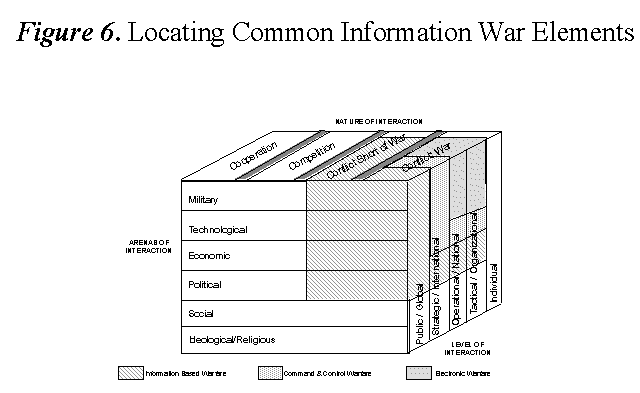
However, only at the most general level of policy and planning can the entire information dominance realm be considered. Useful plans and programs, for offense, defense, and better leveraging existing information will have to focus on particular elements of the problem. Several arenas where U.S. policy makers have experienced difficulty are obvious examples of interactions that are either not military enough or not technological enough to be handled by those who have been thinking about information warfare. For example:
Perhaps more important, there are entire fields where virtually no systematic thinking has been done. One important example is the topic of international technological cooperation in order to acquire information about foreign competition or foreign technologies and to protect technological capabilities. Another is pursuit of selected cooperative development programs by which access to foreign markets and technology is achieved through joint ventures or other arrangements. This field has largely been left to the major international corporations, who are transnational and have no incentive to protect U.S. national interests.
On a different level, very little effort has gone into developing knowledge about how information is processed and decisions are made in foreign societies. Better knowledge of these processes and an ability to understand their dynamics are essential for achieving information dominance. The leverage available from manipulating the way situations and processes are understood, the predictions made by foreign leaders, and the criteria by which they select courses of action is much greater than that inherent in simply manipulating raw data and information. Until this gap is addressed, U.S. policy makers will be working in an unnecessarily simple arena. In the rich realm of information dominance, they will be playing checkers when they could be playing chess.
Linkage across the information dominance realm is absolutely essential to prevent uncoordinated, piecemeal strategies and tactics and "open flanks" that can be readily exploited. In the Cold War, for example, U.S. moral, political, economic, social, technological and military policies were drawn from a common perspective and coordinated against common goals. In the absence of a single, massive threat, much of this coherence has been lost. The information dominance realm offers a meaningful opportunity to improve this situation.
Table of Contents | Appendix C |